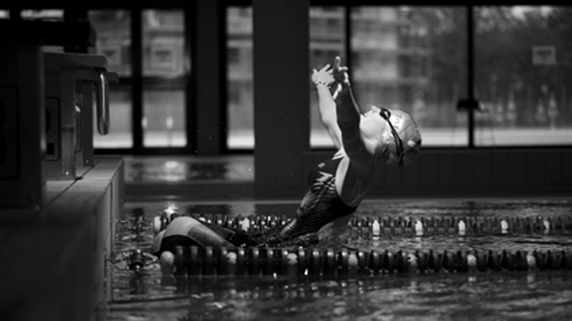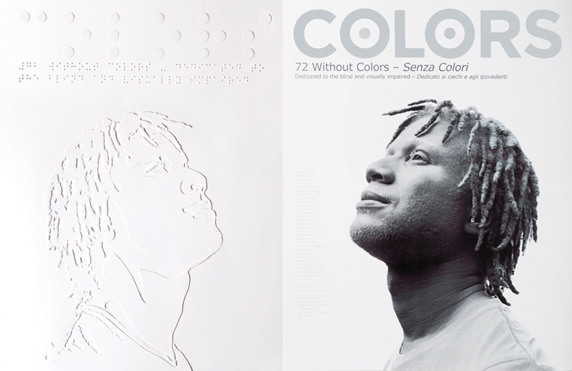|
Colors in Black
and White by Silvia
Colombini A
preview of the monographic issue of the famous international magazine
dedicated to blindness. |
|
Sold in more than 40 countries, published
in 3 editions and 4 languages, present on the Internet with one of the
most visited Web site by young people in the world. This is Colors, a quarterly magazine
exploring different themes in each issue and interpreting them in a new
and uncommon perspective. As a matter of fact, in the last fifteen years,
Colors has dealt with and
analyzed thoroughly a number of subjects, those that are largely ignored
by the general publishing industry, and in its last issue of the year 2007
the focus is on the world of blindness. For a magazine which has always
privileged the use of images, even from an innovative and provocative
perspective, choosing blindness is to say the least, peculiar.
Photographer, author of important news reports, a man with a rare
sensitivity, author of social and cultural communication projects,
narrator and today director of Colors, Enrico Bossan speaks to
us. He explains to us the reason behind this unusual choice.
Photo - Rap
singer Rob Quest 1 "So,
we decided to discover the world of blindness with the belief that there
was something to learn. Our
magazine has always shown inquisitiveness, and we began this adventure
understanding that the inquisitiveness experienced by people who don't see
could help us, and could make us see the world better." The name Colors communicates the intention
of giving the many visions of reality, to show all its aspects, all its
colours, and this issue is the first to come out in black and
white. |
Photo - Brazilian blind swimmer | |
|
White and black
allow us to rediscover the world in a new way." Apart from the chromatic
choice, it is obvious, judging by the cover, that there was a lot of
attention and care involved in the realization of the issue. As a matter
of fact, the editorial staff did research and involved institutions for
the blind and visually impaired in order to arrive at this wonderful final
result. "We created a tactile front page composed of a portrait in raised
lines which was then printed behind therefore allowing a blind person to
read it. Aside from this tactile image, we inserted a CD in four languages
containing the whole magazine to listen to, and also four musical pieces
composed by one of the protagonists in our stories, a musician gipsy. He
will accompany us to all our presentations of the magazine. From Rome to
Madrid, he will be with us on every public occasion to tell people about
his experience, his story. "And here we arrive at the content of the
magazine. Even
though it will address images, there is considerable importance given to
words. Enrico Bossan has
paid particular attention not only to the quality of the images but also
the texts. "We have looked for stories that would tell the rest of the
world the value that blind people represent for society. These are stories
of courage, dignity and adventure. There are people living with vision
loss who have challenged the limits imposed on them because of their
disability." |
In so many
stories and so much black and white, however, there are only two pages in
colour. They are dedicated to the most moving story which is about a
school in New York where blind children learn every day, it is told by
teachers and students. It is a way to see beyond conventions, and a way to
tell it to us that is both original and moving. "This was a challenge for
us. I think it was important to address the subject unhurriedly, but
rather to take the time to talk about it, the time necessary to understand
and see. The magazine will soon be online and accessible to people living
with vision loss, with a blog where it will be possible to write comments.
That's
how this very special issue of Colors concludes. What I would really like is that from our
pages we feel a breath of fresh air. I believe that the magazine provides
a feeling, an emotion. Content with our sight, we too often lose important
emotions. To feel, to perceive, to touch. A teacher told me: ‘Often, not
being able to see obligates us to get closer to people, to the world
around us.’ So,
I hope that Colors, this Colors,
gets closer to its
readers." | |
|
| ||


